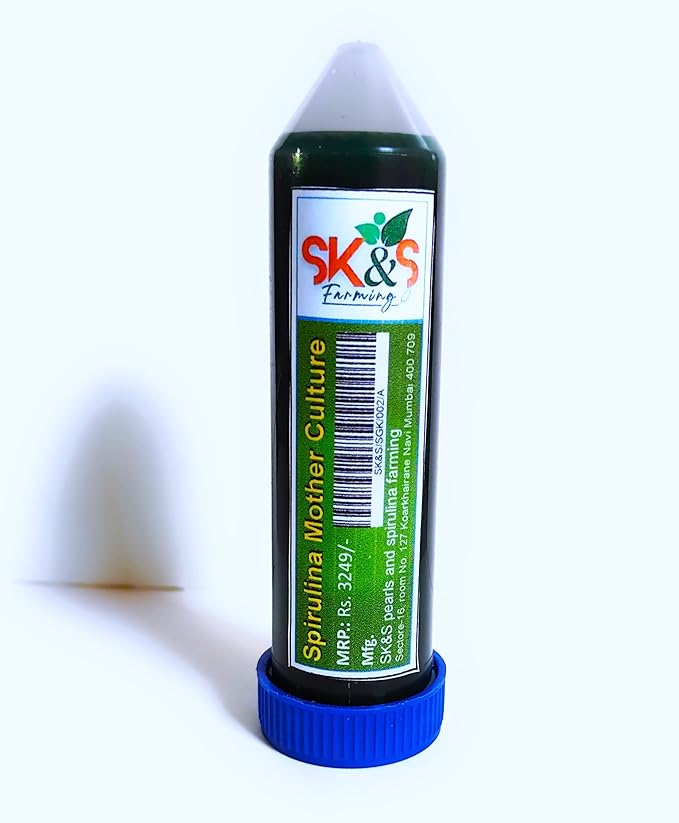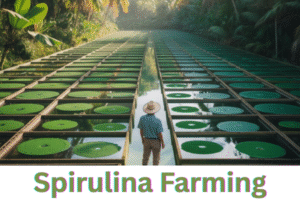Introduction:
spirulina is known as blue-green algae (cyanobacteria) species that exists in both freshwater and seawater. Due to its importance as a food, it is commonly taken as a nutritional supplement.
It is rich in protein, vitamins (especially B vitamins), minerals such as iron and magnesium, and antioxidants such as phycocyanin.
It’s commonly used for:
- Boosting energy and immunity
- Supporting detoxification
- Providing plant-based protein
- Fighting inflammation and oxidative stres

Table of Contents
Types of Spirulina:
Depending on the species and cultivation source, three main types of spirulina are commonly used as dietary supplements:
- it’s platensis is The most commonly cultivated and demanding consumed variety. Lives in fresh water. Rich in protein, B complex vitamins, iron and other antioxidants. Available in powder, tablet and capsule form.
- it’s maxima Grows naturally in alkaline lakes, especially in Central America. Different in nutrient composition, but provides similar benefits to platensis. Also widely used in supplements.Feedback Improve your speaking Practise
- fuciformis is found in natural environment.

Key Aspects of Spirulina Agriculture:
Species Selection:
When choosing a species of Spirulina for cultivation, supplementation or commercial use, the choice depends mainly on the nutritional profile, growth conditions and yield efficiency. There is a comparison of the main species:
Cultivation System.
When choosing a species for cultivation, supplementation or commercial use, the choice depends mainly on the nutritional profile, growth conditions and yield efficiency. The comparison of the main species is as follows:
Setting Up a Farm
1.Site Selection:
Choose an area with adequate sunlight, stable power supply, and availability of clean water. A greenhouse setup can help control temperatures and protect cultures from contamination.
2.Pond Design:
Spirulina is usually grown in shallow, raceway ponds or tanks made from concrete, plastic-lined pits or fibreglass. These should be about 20-30 cm deep and fitted with paddle wheels to allow for constant agitation, ensuring even distribution of nutrients and exposure to light.
3.Nutrient Medium:
A suitable growth medium includes a mixture of sodium bicarbonate, urea or nitrate fertilizer, potassium sulfate, magnesium sulfate and trace minerals. These components help stimulate optimal biomass production
4.Culture Inoculation:
The initial Spirulina culture (seed culture) is introduced into the pond. Under the right conditions the culture grows rapidly and is ready for harvesting in about 7-10 days.
4.1.Water Ph:
To grow Spirulina, make sure the pH of water should be 8.5 to 10:30.
4.2.Mother Culture:
Spirulina mother culture is a living culture of spirulina algae that is used to start cultivation. It is essentially a starter kit for growing spirulina, a nutrient-rich microalgae.
4.3.Mixing and Aeration:
After putting the mother culture in water, the water is continuously stirred with the help of a wheel. The culture is ready in approximately 15 days which you can receive daily.
4.4.Waterb Temparature:
25-30degree Celsius.
4.5.Light Intensity:
1500-4500lux.
4.6.Growth Rate and Production:
Cultivated growth rates of spirulina can vary, but generally increase in biomass within 3-5 days. Typical growth rates can range from 0.5 to 6.1 per day depending on the strain and environment.
5.Harvesting
5.1.Centrifugation
After 5–7 days of growth, the Spirulina biomass is dense enough for harvesting.
The Spirulina is separated from the water.
5.2.Filtration
The water containing is pumped through a fine mesh filter or cloth screen (typically 30-60 microns) to separate the biomass from the culture medium. The filtered culture medium is usually returned to the pond for reuse.
5.3.Washing
The clinical paste is rinsed several times with clean, cold water to remove detergents, odors and excess salts.
6.Drying
Type of drying
- Sun drying (low-cost but slower and quality may degrade)
- Solar tunnel drying
- Spray drying (fast, retains nutrients, more costly)
- Freeze drying (best nutrient retention, most expensive)
7.Grinding
Grind the chips of dry spirulina propery.
8. Pellets/Capsules
make capsules or pellets from power of spirulina.
9. Packaging
Packed it properly in air tight and moisture proof pouch or container.
10. Demand
It is high demand product for dietry suppliments for human and pet animals.
11.Capital Investment Cost
Serial number Perticulars Cost:
| 1 | Pond construction (20@50000) | 10,00,000/-rs |
| 2 | Plant machinary | 15,000rs |
| 3 | Laboratory equipment | 5,000rs |
| 4 | Water treatment plant | 1,50,000rs |
12. Subsidies
The subsidy for it’s farming is 40% of the system cost for small and marginal farmers and 20% for other farmers. The maximum subsidy per hectare is Rs. 60,000.
Some govt departments which helps for stablishment and subsidy
13.Conclusion
Spirulina farming offers a sustainable, low-cost and high-yield opportunity to increase both nutrition and income, especially in resource-limited settings. With its rich protein content, fast growth rate and minimal resource requirements, Spirulina stands out as a superfood with global demand.
In India, increasing government support, access to training programs and growing health awareness have created a favorable environment for its cultivation. By adopting Spirulina farming, individuals and communities can contribute to nutritional security, environmental sustainability and economic empowerment.
Mushroom farming and vermicompost is also a very good businesses opportunity for farmers.


Spirulina is truly a remarkable superfood with its rich nutritional profile. It’s fascinating how it can be cultivated in controlled environments like greenhouses or shallow ponds. The process of growing spirulina seems quite intricate, requiring specific conditions like pH balance and nutrient-rich water. I wonder how the nutritional content varies between different species of spirulina. What are the key factors to consider when selecting a species for commercial cultivation? WordAiApi
Choose a species like L. platensis or L. maxima that thrives in your local pH, salinity, and temperature environment. Then evaluate its nutrient yield in your intended cultivation system (open pond vs. closed), ensuring it delivers high protein, pigments, and micronutrients while resisting contamination.